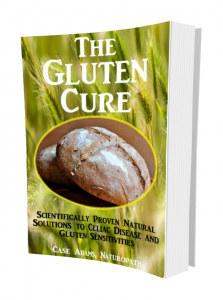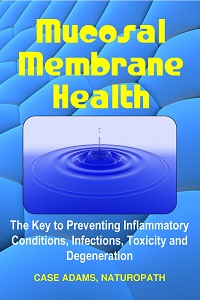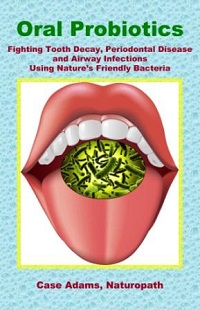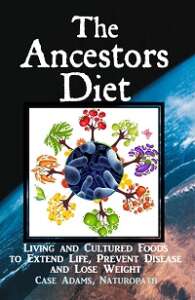Gluten Digested by Enzymes from Probiotics
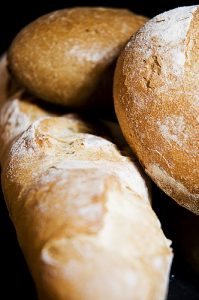
Photo by Katrin Gilger
The scientific evidence continues to prove that a healthy body is naturally able to digest gluten without sensitivity or allergic reaction.
I cover the science in my book on the topic. But one of the newest pieces of evidence illustrates the reality with clarity: Certain probiotics produce enzymes that break down gluten and gliadin proteins. They break down gluten proteins known to cause allergies and sensitivities if they are not broken down.
As my book shows, many of these probiotics are present in the intestines of healthy people – those who are not sensitive or allergic to gluten (celiac disease).
Certain probiotics – that colonize in healthy intestines – break down gluten and gliadin proteins to the point where they do not trigger an immune response.
This means the gluten and gliadin proteins are broken down into amino acids or small enough peptides that make them nutrients: And no longer recognizable as gluten or gliadin proteins.
The natural enzyme response produced by these probiotics was enough to convince the researchers that the enzymes could be employed for celiac patients: A small portion of the population who is allergic to gluten and/or gliadin proteins from wheat.
For those of you who might not understand this point of enzymes that break down (or cleave) proteins, let’s use a crude example:
Let’s say that you are going to install some 8-inch square pavers into your driveway. So you order up some paver blocks from the local building supplier. But instead of delivering you a pallet of pavers, the building supplier truck pulls up to your house with a gigantic boulder on the flatbed of the truck. What do you do?
Certainly, you will call the building supplier and tell them to take the boulder back. You cannot use a giant boulder. You can only use the pavers. Now you and the building supplier knows the pavers are made from crushed up boulders. But the boulder must be crushed down into powder before it can be molded into pavers.
In other words, these large gluten and gliadin proteins might be compared to large boulders – which the body cannot handle and sees as foreign. The body utilizes amino acids or small blocks of amino acids called peptides to make its own proteins. It’s not like the body will utilize complex proteins from our foods – even nuts or plant proteins – directly. They must be broken down into their components in order for the body to utilize them.
In this article
Gut Probiotics break down glutens and gliadins
In this most recent 2016 study, researchers from Boston University’s Henry M. Golden School of Dental Medicine took isolated an enzyme from a family of probiotics found in the gut and in human saliva: Rothia species.
Rothia species such as Rothia mucilaginosa, will inhabit the upper intestines of healthy people. The researchers found that R. mucilaginosa and other Rothia probiotic bacteria will secrete certain types of enzymes.
In the study, the researchers isolated enzymes from R. mucilaginosa probiotics – called Rothia subtilisin or Rmep. They added the enzymes to a mixture of gluten and gliadin proteins.
Essentially, they created a laboratory culture mirroring what happens within the body. They found the enzymes broke down the gluten and gliadin proteins, to the point where they could no longer produce an allergic or sensitivity response.
This was done by analyzing the remaining peptides and amino acids in the culture. The gluten and gliadin proteins were no longer whole. They were broken down. And the sequences of peptides that are known to produce an immune response were no longer around. The boulders had been crushed into dust.
The researchers stated:
“The gluten-degrading enzymes of Rothia were identified as members of the subtilisin protease family. The gluten-degrading activities of this class of enzymes were shown to extend beyond the Rothia genus.”
This last point illustrates that the researchers found other probiotics also produce similar enzymes that break down gluten and gliadin proteins.
Food probiotic produces gluten-cleaving enzymes
The researchers also tested a similar enzyme produced by frequent gut probiotic species, Bacillus licheniformis. They also tested Bacillus subtilis from Nattokinase.
Both organisms produced a gluten-cleaving class of enzyme called subtilisin A.
The researchers tested these enzymes in the presence of gluten and gliadin proteins and found the same thing happened: The enzyme broke down the gluten and gliadin proteins into small peptides and amino acids. They were no longer recognizable as gluten by the immune system.
The point here is that the probiotic species of bacteria tested by the researchers revealed a type of enzyme that is common to other probiotics – including those that also inhabit the intestinal tract. In my book, I discuss a number of other probiotics found in the gut that break down gluten and gliadin proteins.
Yes, the science has proven that certain probiotics break down gluten and gliadin proteins. This is because these probiotics feed off the gluten and gliadin proteins. So naturally, they produce enzymes that break down those proteins. Other probiotic-producing enzymes include prolyl endopeptidase and endoprotease B.
This study introduces other enzymes produced by the gut’s microbiome that break down gluten and gliadin.
The research paper clarifies:
“A novel class of gluten-degrading enzymes were isolated from Rothia bacteria… The enzymes were identified as subtilisins belonging to the S8 family of peptidases. Food-grade Bacillus species also produce such subtilisins, and these were also able to cleave and abolish gluten immunogenic epitopes. Subtilisins, cleaving after XPX↓, represent an as yet overlooked class of enzymes with great potential for enzyme therapeutic applications in celiac disease.”
Of course, the researchers are looking for commercial applications to their study. Because research is financed by commercial products, they entertain the mass production of enzymes to give to celiac disease patients. This way, the celiac patients have a pill that allows them to be able to eat foods containing gluten.
As I discuss in my book, there are already some commercially-available enzymes that can help people digest gluten. And this is certainly an option. But the more sustainable solution is for us to colonize our guts and oral cavities with the probiotics that produce those enzymes.
Other research supports Rothia breaks down gluten
A 2011 study from Boston University tested Rothia mucilaginosa and Rothia aeria bacteria derived from the intestinal tract. Again, the researchers found that gluten and gliadin proteins were broken down by these bacteria. The researchers stated:
“While the human digestive enzyme system lacks the capacity to cleave immunogenic gluten, such activities are naturally present in the oral microbial enzyme repertoire. The identified bacteria may be exploited for physiologic degradation of harmful gluten peptides.”
Implications for growing gluten sensitivities
I lay out a number of science-backed reasons for the growing incidence of gluten sensitivities in my book. One of the more pronounced of these relates directly to the loss of our natural probiotic colonies. This relates to a number of factors, including the proliferation of antibiotics, antiseptic soaps and cleaners, pesticides and herbicides in our environments and foods. An imbalanced saliva and mucosal pH also deters the growth of our natural probiotic bacteria.
Each of these factors together or separately endanger our body’s ability to harbor and retain healthy probiotic colonies. For example, a two- or three-week course of antibiotics may knock out many species of our natural probiotics – in our guts and our oral cavity. The result is typically called dysbiosis: An unhealthy microbiome.
Some of these probiotics killed off by antibiotics are sure to be producers of gluten-cleaving enzymes. How will our bodies break down these complex gluten and gliadin proteins (‘boulders’) otherwise?
The result is unbroken down gluten and gliadin proteins being presented to the intestinal walls. These gluten proteins are oversized and unusable by the body.
Because the intestinal wall maintains a host of immune cells and immunoglobulins, these large proteins produce an immune response.
In healthy bodies, the gluten proteins are broken down by the enzymes produced by these probiotics. But when those probiotics are killed off, the undigested gluten proteins are considered foreign to the body.
Now some people will respond with an allergic response – in the case of celiac patients. Others will become more tolerant, but may still respond with a gluten sensitivy response. Still others may be completely tolerant and have no response, or a more latent (delayed) response.
Formulating an enzyme supplement that will break down gluten is not very sustainable. It could be nice in a pinch, mind you.
The far more productive and sustainable approach would be to rebuild our body’s natural colonies of probiotics that produce gluten-cleaving enzymes.
When Rothia enzymes don’t break down gluten
One interesting point I should add: The researchers found the gluten-cleaving enzymes were not productive when the pH of the culture was too low. The enzyme was active in a pH range of 6.0 to 10.0.
This is important because if the pH of the oral cavity or upper intestines is too low (too acidic) then the enzymes from the Rothia species are not productive in breaking down gluten.
Rothia species of bacteria can also overwhelm the oral cavity as well. When they do this, the bacteria can work with other bacteria to cause periodontal disease. In these situations, the acidic nature of the saliva will not allow the Rothia bacteria to break down gluten.
This was shown in a 2014 study of 26 children, half of which had celiac disease. Those celiac children had higher counts of pathogenic bacteria known to cause periodontal disease (such as Porphyromonas endodontalis and others). They also had higher levels of Rothia species in their oral cavities – greater than the healthy kids, which also had Rothia species in their oral cavities. But since the celiac kids also had highly acidic-producing pathogenic bacteria, the Rothia bacteria did little to break down their gluten.
This notion of the wrong balance of bacteria in the wrong places also occurs with Lactobacillus acidophilus. L. acidophilus is an extremely healthy species of intestinal bacteria. But it will sometimes over-colonize the oral cavity, where it can produce acids that break down enamel and produce dental caries.
The bottom line is that some species of probiotics have their normal residences. But when they colonize the wrong places, they can cause problems.
REFERENCES:
Wei G, Tian N, Siezen R, Schuppan D, Helmerhorst EJ. Identification of food-grade subtilisins as gluten-degrading enzymes to treat celiac disease. Am J Physiol Gastrointest Liver Physiol. 2016 Sep 1;311(3):G571-80. doi: 10.1152/ajpgi.00185.2016.
Wang C, Du M, Zheng D, Kong F, Zu G, Feng Y. Purification and characterization of nattokinase from Bacillus subtilis natto B-12. J Agric Food Chem. 2009 Oct 28;57(20):9722-9.
Francavilla R, Ercolini D, Piccolo M, Vannini L, Siragusa S, De Filippis F, De Pasquale I, Di Cagno R, Di Toma M, Gozzi G, Serrazanetti DI, De Angelis M, Gobbetti M. Salivary microbiota and metabolome associated with celiac disease. Appl Environ Microbiol. 2014 Jun;80(11):3416-25. doi: 10.1128/AEM.00362-14.
Adams C. The Gluten Cure: Scientifically Proven Natural Solutions to Celiac Disease and Gluten Sensitivities. Logical Books, 2014.

